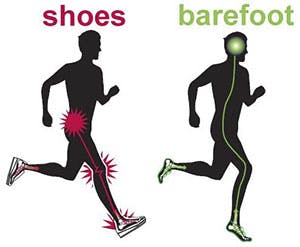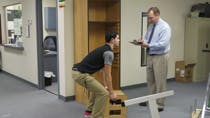After Christopher McDougall’s book “Born to Run” became a national bestseller in 2009, the running world was turned upside down by the notion that the current running shoe model may be one of the leading causes behind the high prevalence of injuries to runners. After reading the book, millions of runners around the world decided to ditch their expensive running shoes for the Vibram FiveFingers (the funny looking toe shoes) or something of the like. During their running shoe transition, many runners experienced lower leg injuries which eventually led to a class action lawsuit against the Vibram FiveFinger company in 2014 for making false health claims.
However, the question still remains: is barefoot or minimalist running beneficial to running athletes? The research published in some of the most respected physical therapy and sports journals in the world suggests that barefoot running may have significant advantages in improving running mechanics, performance, and decrease the risk of injury.
Barefoot running encourages a forefoot strike which has been shown to reduce the risk of injury compared to a rearfoot strike pattern. Have you ever tried going outside and running on your heel? I promise you won’t last long. That’s because a forefoot strike is more forgiving than the more common rearfoot strike pattern. Landing on the front of your foot allows for the small muscles in your feet, Achilles tendon, and calf muscles as well as the quadriceps to all work together to help dampen the impact during each stride. When you land on your heel, all of the force is immediately felt in the bony heel and transferred up the chain to the knees and hips. That might not be a big deal for one step, but when the process is repeated over an extended period of time, overuse injuries are inevitable. It’s probably not a coincidence that 95% of runners land on their heel and 80% of runners are injured in a given year.

In addition to the benefit of a forefoot strike, barefoot running increases sensory feedback when the foot hits the ground and increases the energy storage in the arch and Achilles tendon. This allows the Achilles to act similar to a spring, absorbing the shock and rebound, decrease the amount of effort required in the push off phase of the running cycle.
So if there are so many benefits to barefoot running, why was there an increase in the amount of injuries to the runners that tried it out? The answer likely lies in a flawed transition period. Making the transition to barefoot running takes a long time (conservatively, 1-2 years) for a number of reasons. Number 1, people have been living in a literal foot cast for most of their lives. When you put your leg in a cast after an injury, it doesn’t take long for the immobility to cause severe atrophy and weakening of the muscles in the leg. Likewise, the shoe acts as a cast for the small muscles in the bottom of the foot, not allowing them to work and causing them to become weak. It takes time to build up the strength of these muscles. Number 2, it also takes time to recreate the way you run. There is a significant biomechanical difference between rearfoot and forefoot striking. It takes time and effort to transition properly.
If you have a desire to run in a more efficient way and reduce your risk for injury, please contact one of our offices to get more information. Our physical therapists that we have on staff are well educated in the most up-to-date research regarding running rehabilitation. We will work with you in order to help you get over a current injury and even prevent a future injury.


